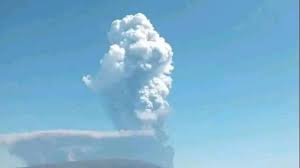A massive volcanic ash cloud from the long-dormant Hayli Gubbi volcano, which erupted on Tuesday in Ethiopia, has now travelled thousands of kilometres and entered India. The plume first reached Delhi late Monday night around 11 pm, after crossing the Red Sea and passing over Yemen and Oman.
Meteorological data indicates that the ash is spreading across several Indian regions, including Delhi-NCR, Gujarat, Rajasthan, Punjab, Haryana, and Maharashtra. Weather experts have also warned that the cloud will eventually drift toward the Himalayas and the Terai region of Uttar Pradesh.
According to IndiaMetSky Weather, the plume contains volcanic ash, sulphur dioxide, and microscopic rock particles, which can impact visibility and air travel depending on its density.
How Fast Is the Ash Cloud Moving?
Satellite tracking shows that the plume is travelling at a speed of 100–120 km/h over North India, at an altitude ranging between 15,000 and 25,000 feet, and in some layers possibly rising as high as 45,000 feet.
When Will India Be Free of the Ash Cloud?
India Meteorological Department (IMD) Director General Mrutyunjay Mohapatra confirmed that the cloud is moving away from India and drifting toward China next. The ash influence is expected to clear Indian skies by 14:00 GMT (7:30 pm IST) on Tuesday.
Earlier IMD reports confirmed that the volcanic plume initially rose to around 45,000 feet, carried by strong high-level winds.
Aviation Advisory and Flight Disruptions
Following advisories issued to airlines due to hazardous flying conditions, IMD’s Meteorological Watch Offices in Mumbai, New Delhi and Kolkata have been monitoring the ash movement using real-time satellite feeds and updates from global Volcanic Ash Advisory Centres.
The situation has already affected international travel. As reported by Reuters, Akasa Air has cancelled flights to and from Jeddah, Kuwait, and Abu Dhabi scheduled for November 24 and November 25 due to safety concerns.
Tracking Future Movement
With global weather models predicting the plume’s shift toward East Asia, meteorological agencies across multiple countries continue to monitor its movement. While no major health advisory has been issued yet, experts recommend precautions for sensitive individuals in affected zones, especially those with respiratory conditions.















